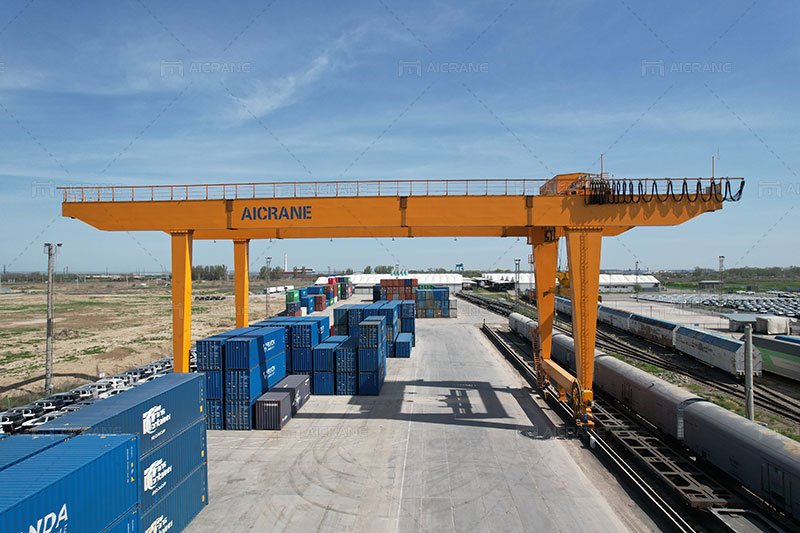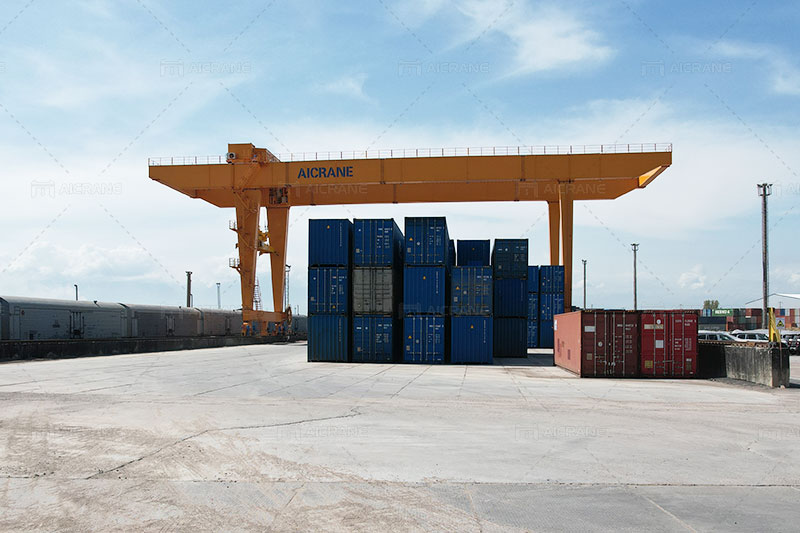The evolution of the global shipping industry has driven ports to become highly competitive and dynamic environments. As international trade expands, the need for ports to operate efficiently and securely has never been more critical. One of the key innovations transforming port operations is the integration of automation technologies with rail mounted container gantry cranes (RMG cranes). These cranes, crucial for container handling, are being modernized with automation to achieve enhanced productivity, improved safety, and reduced costs.

Understanding Rail Mounted Container Gantry Cranes
Rail mounted container gantry cranes (RMG cranes) are an essential component of modern port infrastructure, specifically designed for loading, unloading, and stacking containers on the quay side. These cranes are mounted on rails, which allow them to move horizontally along the dock and transport containers to and from large ships. With increasing global trade and container volumes, efficient rail mounted container gantry crane operations are paramount for ensuring that ships are unloaded and loaded in a timely manner.
Traditional RMG cranes, while effective, often face limitations in terms of speed, accuracy, and the capacity to handle higher volumes of containers. The integration of automation into these cranes is a game-changer, opening the door to smarter, more efficient operations.

The Role of Automation in RMG Crane Systems
Automation refers to the use of advanced technologies, such as artificial intelligence (AI), machine learning, sensors, and robotics, to automate tasks that were traditionally manual. In the context of rail mounted container gantry cranes, automation can optimize several key processes:
-
Automated Navigation and Operation
Traditional RMG cranes rely on human operators to control crane movements, which can lead to inefficiencies due to human error or inconsistent decision-making. Automated navigation systems use sensors, GPS, and real-time data to allow the automated rail mounted gantry crane to move along the rail, precisely positioning itself over containers without manual intervention. This level of accuracy reduces the time spent maneuvering the crane, leading to faster loading and unloading times. -
Container Identification and Handling
Automation systems in RMG cranes are also equipped with advanced container identification technologies, such as RFID tags or optical character recognition (OCR). These systems allow the crane to automatically identify containers, determine their weight and size, and select the optimal handling method. This reduces human error in container handling and improves the efficiency of stacking containers in the yard, which is essential for maximizing space utilization in the port. -
Load Monitoring and Safety Enhancements
Automated RMG cranes are equipped with advanced load monitoring systems that continuously assess the weight and distribution of the container being lifted. These systems can adjust crane movements in real time to prevent overloads and minimize the risk of accidents. Additionally, the integration of sensors and cameras helps enhance safety by providing real-time monitoring of the surrounding environment, preventing collisions with nearby infrastructure, equipment, or personnel. -
Predictive Maintenance and Operational Optimization
One of the major advantages of automation is the ability to predict and prevent downtime through predictive maintenance. By continuously monitoring the performance of the crane’s components, automated systems can detect potential failures before they occur, allowing for timely maintenance interventions. This reduces unplanned downtime, enhances the longevity of the crane, and lowers overall maintenance costs. -
Advanced Data Analytics for Performance Optimization
The data generated by automated RMG cranes can be analyzed in real time to assess crane performance, container handling times, and other critical operational metrics. By utilizing machine learning algorithms, port operators can gain insights into trends and patterns that may otherwise be difficult to detect. These insights enable operators to optimize crane operations, adjust workflows, and make data-driven decisions that improve efficiency.
Benefits of Automation in RMG Cranes for Ports
The integration of automation with RMG cranes provides several compelling advantages for ports striving to remain competitive in the face of growing demands. These benefits can be categorized into operational, economic, and environmental factors:
1. Operational Efficiency
The primary benefit of automation is improved efficiency. Automated RMG cranes can perform operations at a much faster pace than manual systems, reducing the time required to load and unload containers. The precision of automated navigation systems ensures that cranes are positioned correctly every time, eliminating delays caused by human error. Additionally, automated cranes can operate 24/7, maximizing throughput and reducing turnaround times for vessels.
2. Cost Reduction
Although the initial investment in automation technologies can be significant, the long-term cost savings are substantial. With automation, ports can reduce labor costs, as fewer manual operators are needed to control crane movements. Automated systems also minimize operational errors that can lead to costly damages or delays. Furthermore, the predictive maintenance capabilities of automated cranes reduce repair costs by preventing unexpected breakdowns and extending the lifespan of the equipment.
3. Enhanced Safety
Automating RMG cranes significantly improves safety in ports. Human operators are no longer required to be physically present on the gantry crane, reducing the risk of accidents. The crane’s sensors and safety systems can detect potential hazards in real time, automatically stopping or adjusting the crane’s movements to avoid collisions or unsafe conditions. With fewer workers in high-risk areas, the likelihood of injuries decreases, leading to a safer working environment overall.
4. Environmental Benefits
The integration of automation can also support sustainable port operations. Automated RMG cranes are typically more energy-efficient than their manually operated counterparts, as they are optimized to perform tasks with minimal energy consumption. In addition, the increased operational efficiency allows ports to handle more containers without needing to expand their infrastructure, reducing the environmental impact associated with port expansions.
5. Scalability and Future-Proofing
Automated systems provide ports with the flexibility to scale operations as demand grows. Automated RMG cranes can be easily integrated into existing port infrastructures, allowing for seamless upgrades as new technologies become available. Furthermore, these systems can be adapted to future requirements, such as handling larger vessels or different types of containers, making them a future-proof investment for ports.
Challenges of Integrating Automation into RMG Cranes
While the advantages are clear, integrating automation into rail mounted container gantry cranes is not without its challenges. Some of the main obstacles include:
-
High Initial Investment: The cost of retrofitting or replacing existing cranes with automated systems can be prohibitively high for some ports. While automation offers significant long-term cost savings, the initial capital outlay may pose a barrier to smaller or less financially stable ports.
-
Technological Complexity: The integration of advanced technologies, such as AI, machine learning, and robotics, requires highly specialized knowledge and technical expertise. Ports must invest in training staff and ensuring that the systems are properly installed and maintained.
-
Cybersecurity Risks: As automation systems become increasingly reliant on data and connectivity, cybersecurity becomes a critical concern. Protecting automated systems from cyberattacks or system failures is essential to maintaining the integrity of operations.
The Future of Automated RMG Cranes in Smart Ports
Looking ahead, the role of automated rail mounted container gantry cranes will continue to evolve as ports strive to become smarter, more efficient, and more sustainable. Emerging technologies, such as 5G connectivity, cloud computing, and Internet of Things (IoT) devices, will further enhance automation capabilities, enabling real-time data sharing and decision-making across the entire port ecosystem.
Additionally, as automation technology matures, it will become more accessible to smaller ports and terminals, leveling the playing field and providing even more opportunities for innovation in the industry.
Conclusion
The integration of automation with rail mounted container gantry cranes is a transformative development for the shipping industry. By enhancing operational efficiency, reducing gantry crane costs, improving safety, and supporting environmental sustainability, automated cranes are positioning ports for success in a highly competitive global marketplace. As ports continue to modernize, the integration of automation will play a key role in creating smarter, more efficient, and future-proofed port operations.